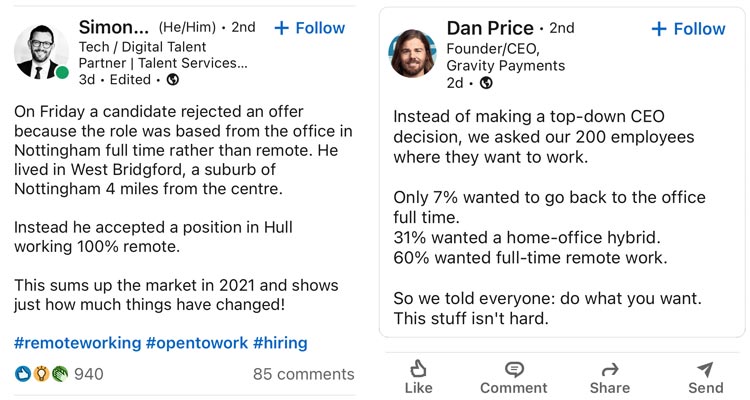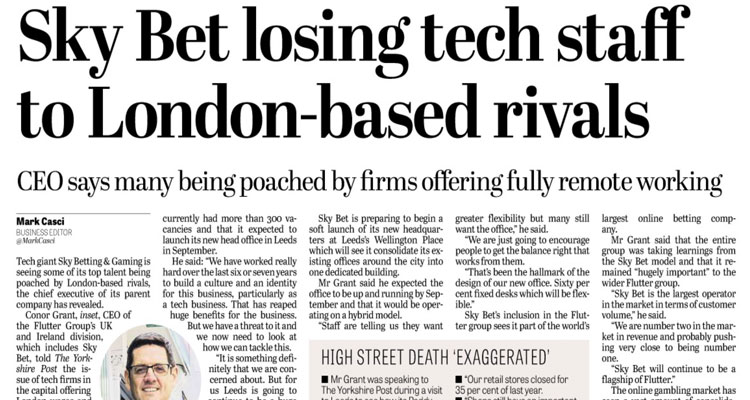Andrew Grove, Intel CEO
It’s fair to say that the last 18 months have been a crisis for many businesses. Covid-19 has been an existential threat to the survival of some, an opportunity for many others.
As restrictions end, it will be tempting to go back to the familiarity of our old ways of working, but this would pass up an extraordinary opportunity to rethink and improve our companies and how we work.
So what have we learned, and what can we improve as we transition into the “new normal”?
When it comes to work, focus on outcomes, not location.
For most companies that don’t produce a physical product, government-mandated home working worked. There’s no way of getting around it. Most businesses that could adapted to remote working quickly and efficiently. 72% of employees in the UK think they are as productive or more productive than they were before the pandemic began.
Everybody’s experience of working from home during lockdown has been different and unique. So if, when and how people return to the office should be unique to them too. We can improve our companies by empowering our teams to decide where and when they work, not by imposing a minimum number of days and core hours.
Asda, a UK supermarket chain, is one of many employers embracing this approach for their head office staff and has dubbed it “work where works best” with employees not required to attend a specific location for a set number of days per week.
We all have different needs to work at maximum productivity. For example, some prefer the buzz of a busy office, and some prefer quiet isolation and the time to think. As a result, two people in the same role can work very differently but be equally successful in delivering positive outcomes.
As managers, we give our teams clear objectives; we don’t tell them how to do their jobs. Insisting on where and when they work is micromanagement. Instead, we should leave them and their peers to decide where and how they can best deliver their objectives.
And we should give them the freedom to flex how and when they work according to the project they are working on or home life challenges they are facing at the time. We need to focus on outcomes, not location or hours worked.

Review your employee offer and benefits.
Everyone who switched to working from home understands what aspects of the ‘new normal’ they consider the most valuable. This could be the lack of a commute, time spent with family or the flexibility to time-shift their working day around picking up the kids or an early morning run.
What was important to people before the pandemic is very different to what’s important to them today. So a great company will know that their employee offer and benefits package needs to evolve if they want to remain an employer of choice.
And it needs to evolve fast. According to research from Personio, 38% of UK employees are looking to change roles in the next 6-12 months, with this number rising to 58% for respondents in IT roles.
Bret Taylor, president and COO of Salesforce, sums it up perfectly “There’s a free market of the future of work and employees are choosing which path they want to go on.”
As I’ve discussed above, flexible working is now a given. But it’s essential also to recognise that some employees will still want an office to work in regularly or permanently. So any thoughts around cost-saving by reducing your office footprint or relocating need to bear this in mind.
That’s right. Great companies will need an all-embracing office environment and an enhanced level of support for employees working at home.
Beyond the standard health and safety measures required by law, I’ve seen companies giving out annual allowances for buying chairs and office equipment. Another company is issuing credit cards to all employees for stationery and supply purchases, and one is paying for lunch one day a week wherever its employees are located.
More and more companies are now looking at offering condensed hours or even, following the “overwhelming success” of a large-scale trial in Iceland, moving to a four-day working week.
With demand for labour outstripping supply in many sectors, changes that seemed radical yesterday are fast becoming the norm. CEO of Sky Betting and Gaming, Conor Grant, has described the poaching of his Yorkshire based team by London companies offering capital city salaries and benefits along with permanent remote working as a “live threat” to his business.
Any employer failing to acknowledge or adjust to the change will be on the receiving end of the “tsunami of resignations” many are forecasting when restrictions end.

When we do come together, there has to be a reason.
Being in a gym doesn’t make you fit. You have to use the equipment or take a class. It’s the same with an office, just being there doesn’t add value. You have to be participating.
I think there are two types of office work. ‘Passive work’, like writing and answering emails, preparing reports or analysing data. Then there is ‘active work’ where we generate ideas, build plans and make decisions.
Look around any pre-pandemic office, and the majority of people were spending most of their time there on ‘passive work’ – staring at a screen, not communicating with colleagues, focused on their task at hand.
And I hate to say it, but most meetings fall into the ‘passive work’ category. We’ve all been in meetings that begin with no agenda, end with no actions and have very little information imparted in-between. Regular update meetings where practically everyone in the room already knows everything that is being discussed.
When lockdown started, the conventional wisdom was that you needed far more meetings with your team to ensure they were working productively and to check that they were coping with the isolation.
With impressive efficiency, calendars filled up with daily check-ins, extra team meetings, wellbeing checks and the obligatory online quiz. Thankfully most of these additional meetings have now fallen by the wayside, and we’ve all settled down into getting on with working remotely.
So as they return to whatever remote or blended future awaits them, great companies will fight the temptation to start having more meetings again just because people are in the same location at the same time.
If you want to be one of them, make sure every meeting has a purpose. In addition, every meeting should only run for as long as is necessary, and you shouldn’t feel the urge to fill up an hour just because when someone designed Microsoft Outlook, they set that as the default meeting time.
And many of your teams, happy working at home, will need an ‘active work’ reason to come into the office, something beyond simple presenteeism: a workshop, a crucial face-to-face meeting, training or knowledge sharing.
If we insist on bringing our teams back to the office to sit staring at a screen doing ‘passive work’, we’ve really missed a golden opportunity to rethink how our businesses work most effectively.
The way we work has been evolving long before the Coronavirus turned the world upside down. All of this may herald a once in a lifetime change in working patterns, and it may not. But right now, it’s front and centre of people’s minds, and it can’t be ignored.
It would be easy to think that your company has survived the worst of it, but in many ways, the return to normal is our biggest challenge yet.
